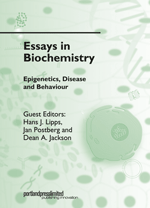WS 2011/12 - SS 2012
PhD students welcome!
http://www.uni-wh.de/gesundheit/forschung-gesundheit/promotion/promotionsboerse/
October 2011: Out now!
Inflammatory Bowel Diseases
Cover image from our article

September 2010: Out now!
Essays in Biochemistry Volume 48
Epigenetics, Disease and Behaviour
Edited by H. J. Lipps, J. Postberg and D. A. Jackson
http://essays.biochemistry.org/bsessays/048/default.htm
 October 5th 2010: The book has been reviewed by Andrew Bannister (University of Cambridge): October 5th 2010: The book has been reviewed by Andrew Bannister (University of Cambridge):
"These days, ask virtually anybody a question concerning the identity of our hereditary material and you'll very likely receive an answer that includes just three letters: DNA. Since Watson and Crick first reported the structure of DNA back in 1953, it was obvious that this molecule had the potential to fulfil a hereditary role. We now know that specific sequences within DNA encode genes, the units of readable information that help define what we are (our phenotype), and that these are passed on from one generation to the next. But this is not the complete story. Additional and distinct layers of information exist which function together with the DNA-encoded information in order to define phenotype. This additional 'epigenetic' information is derived from multiple mechanisms that can give rise to heritable changes in gene-expression programmes without involving a change in DNA sequence. This timely book, Essays in Biochemistry: Epigenetics, Disease and Behaviour, introduces the reader to a number of the mechanisms involved in epigenetic regulation, and it presents examples highlighting the severe consequences that can arise when these mechanisms become deregulated.
At 285 pages, and containing 17 chapters, this book is certainly not a quick read. It is, however, a detailed and well-constructed introduction to the general field of epigenetics. Individually, each chapter is a stand-alone essay focused on a specific area related to epigenetics, and each is comprehensively referenced pointing the reader to appropriate additional reading material. Reassuringly, experts in the respective areas of epigenetic research have written each chapter. Although each chapter is a distinct essay, the editors have done a commendable job in ordering them such that the complete volume has content that flows coherently from start to finish.
Before one can consider the mechanisms involved in epigenetic regulation, it is important to appreciate the physical locality in which these processes occur. The first two chapters provide insight into this by discussing how evolution has helped to shape the nucleus and, in turn, how the nuclear organization presents an environment amenable to epigenetic control. Evolutionary perspectives are often overlooked in books of this type, but in this offering, the topic provides an interesting and thought-provoking opening.
The next three chapters introduce the reader to chromatin, the structure in which DNA is packaged. Chapter 3 discusses histone post-translational modifications and DNA methylation, and their cross-talk.
These types of modification are at the core of the epigenetic concept as they have the potential to be transmitted from one generation to the next. Chapters 4 and 5 discuss how nucleosome remodelling and histone variants respectively may also contribute via the assembly of heritable epigenetic structures.
Currently, a significant focus in the epigenetic field involves the analysis of RNAs and how they may regulate epigenetic events. Chapters 6 and 7 describe two model systems useful for these analyses. The first discusses RNA-directed epigenetic regulations of DNA rearrangements in ciliates and the second describes a mouse model system indicating that RNAs in spermatozoon may be carriers of epigenetic information.
The next chapter looks at how the levels of potential epigenetic chromatin modifications change through the cell cycle. This is important because the cell cycle is obviously linked to the production of daughter cells and consequently cell-cycle-dependent changes in modification patterns are likely to have relevance to inheritance of a particular chromatin state.
Having set the scene, the `back nine¿ chapters, in turn, discuss (i) how deregulated 'epigenetics' can lead to various diseases including cancer, (ii) two useful model systems, and (iii) how epigenetic mechanisms are involved in various aspects of development. Together, they present a compelling case for the importance of epigenetics in health and disease. It is crucial to have a good understanding of these processes because, unlike DNA mutations, aberrant alterations to the epigenetic landscape are potentially reversible. This strongly suggests that they may be good targets for therapeutic intervention.
In summary, this book provides an excellent broad introduction to many aspects of epigenetic mechanisms. Each chapter is informative and, importantly, up-to-date. As a whole, an experienced researcher will appreciate and value it just as much as a relative novice."
http://www.biochemist.org/reviews/page.htm?item=2641
| 